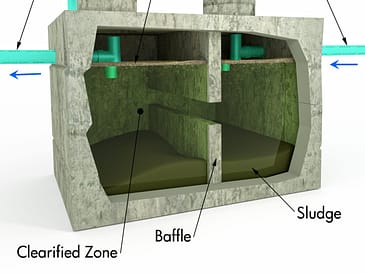If you’re in the process of building a new home or renovating your current one, you might be wondering about installing a new septic tank. While this task may seem daunting at first, it is essential to ensure that your wastewater is properly disposed of and does not harm the environment. But with so many questions surrounding septic tank installation, it can be tough to know where to start. That’s where we come in – in this article, we’ll answer some common questions about installing a new septic tank and give you the information you need to make an informed decision.
In this article, we’ll take a closer look at topics such as choosing the right septic tank for your needs, how much it will cost to install one, and who you should hire for the job. We’ll also discuss what happens during the installation process and why regular maintenance is crucial for keeping your system functioning correctly. By the end of this article, you’ll have a better understanding of what’s involved in installing a new septic tank and feel more confident about moving forward with this exciting project.
The Basics of Septic Tank Installation
Septic tank installation is a crucial process that involves the proper design, planning, and execution of a septic system. Installing a septic tank requires careful consideration and attention to detail since any mistakes can lead to costly repairs or even hazardous health risks. Here are some basics you need to know about septic tank installation:
Site Evaluation and Permits
The first step in installing a septic tank is site evaluation. Professionals will conduct soil tests to determine if the land can support the weight of the system, assess the groundwater level, and check for other environmental factors that may affect the installation process. Permits are also necessary before any work begins. This includes obtaining permits from local health departments or building code offices, as well as complying with state regulations.
It’s important to remember that every area has different laws governing septic tanks installations, so it’s essential to research your local regulations before proceeding with any work.
Tank Size and Material
Choosing the appropriate size and material for your septic tank is another crucial aspect of installation. The size needed will depend on your household’s water usage rate and how many people live in your home. A professional contractor can help you choose the right size based on these factors.
The most common materials used for building tanks are concrete, fiberglass, and plastic. Concrete tanks are more durable but require more maintenance than fiberglass or plastic tanks that typically have longer life expectancies.
Distribution System Design
The distribution system design involves designing an effective drainage field where wastewater will be distributed after leaving your septic tank. The drainage field should be properly sized based on soil type, which impacts how well water can infiltrate into it over time without saturating it.
Proper septic tank installation is critical for the proper functioning of your system and the avoidance of costly repairs or health hazards. An experienced professional can guide you through each step of the process and ensure that your septic system meets all legal requirements and functions efficiently for years to come.
Choosing the Right Septic Tank
One of the most critical steps in installing a new septic system is choosing the right septic tank. There are several factors to consider when making this decision, so it’s essential to be informed before making your choice.
Tank Size
The size of your septic tank will depend on how many people are in your household and how much water you use. The average residential septic tank holds about 1,000 gallons and is suitable for a family of four. However, if there are more people living in your home or you have high water usage, you may need a larger tank. In contrast, smaller tanks may be appropriate for vacation homes or small households with low water usage.
It’s important to note that having an oversized or undersized septic tank can cause issues with the efficiency of your system and can result in frequent backups or overflows.
Tank Material
Septic tanks come in various materials such as concrete, plastic (polyethylene), and fiberglass. While each has their benefits, concrete is still the most commonly used material due to its durability and long lifespan.
Polyethylene tanks have also grown increasingly popular due to their lightweight structure that makes them easy to install. Fiberglass tanks are strong but can be brittle; therefore, they may not be appropriate for areas with rocky soil.
Tank Shape
The shape of your septic tank should also be considered when making a choice. Square-shaped tanks provide more volume than round tanks but don’t fit as efficiently into tight spaces like round ones do. If space isn’t an issue, then consider using square-shaped since they generally require less digging than round-shaped ones during installation.
In summary, selecting the right septic tank is a crucial part of installing a new septic system. Ensure you consider factors such as tank size, material, and shape before making your decision. By doing so, you’ll help keep your system operating efficiently for years to come.
How Much Will It Cost to Install My Septic Tank?
When considering installing a new septic tank, one of the most pressing concerns is how much it will cost. The price can vary depending on several factors, including the size of the tank and the complexity of the installation. On average, you can expect to pay between $3,000 and $7,000 for a new septic tank installation. The size of your household will determine how big your septic tank needs to be and ultimately impact its cost. A bigger tank will be more expensive than a smaller one. In addition to the size of the tank itself, you’ll also need to consider other expenses like soil testing and permits that may be required by your local municipality. In some cases, the location of your property may also affect septic tank installation costs. For example, if you live on sloped land or in an area with high water tables that require additional excavation work or special considerations during installation, these factors could increase costs as well. It is always best to get a detailed estimate from a professional installer before making any final decisions about installing a new septic system.
Septic Tank Installation: Who Should I Hire?
When it comes to installing a new septic tank, it is essential to choose the right person for the job. A poorly installed septic system can cause significant problems and lead to costly repairs down the line. Here are some factors to consider when choosing who to hire:
Experience and Qualifications
The first thing you should look for is a qualified professional with experience in installing septic systems. A skilled contractor will have specialized knowledge of soil types, regulations, and installation techniques in your area. They will also carry appropriate licenses, insurance coverage, and other credentials required by local authorities.
A reputable installer will be happy to provide references from past clients. Be sure to follow up on these references by contacting them directly and asking about their experience with the installer.
Reputation
Hiring a contractor with a good reputation is crucial when it comes to septic tank installation. Look for installers who have been recommended by friends or family members or who have received positive reviews online. It’s also important to check if there have been any complaints filed against them with local consumer protection organizations.
You can also research potential contractors on websites like Angie’s List or the Better Business Bureau (BBB).
Pricing
The cost of installing a septic tank can vary widely depending on factors such as tank size, soil type, accessibility of the site, and more. When comparing quotes from different contractors, be sure that you are comparing apples-to-apples in terms of what services are included in each quote.
Avoid choosing an installer solely based on price; instead, consider all of these factors together before making your final decision. Remember: paying slightly more upfront for quality work can save you significant money and headaches in the long run.
How Long Does It Take to Install a Septic Tank?
Septic tank installation is a complex process that requires careful planning and execution. One of the most common questions people ask when considering a new septic system is how long it will take to install. The answer depends on several factors, including the size and type of septic tank, the condition of the soil, and any site-specific challenges that may arise during installation.
The Timeline for Septic Tank Installation:
The timeline for septic tank installation can vary significantly depending on several factors. In general, however, it takes between three and five days to complete the job from start to finish. Here is a rough timeline of what you can expect during each phase of the project:
- Site preparation: Before installing your new septic system, your contractor will need to excavate the site and prepare it for installation. This can take anywhere from one to three days depending on the size and complexity of your system.
- Tank placement: Once the site is prepared, your contractor will place your new septic tank in its designated location. This usually takes one day.
- Piping and connections: After placing the tank, your contractor will connect it to your home’s plumbing system with pipes. This process usually takes one day.
- Inspection: Before completing the project, your contractor will need to perform a final inspection of your new septic system to ensure that everything has been installed correctly. This typically takes one day.
Factors That Can Affect Installation Time:
Several factors can affect how long it takes to install a new septic tank. These include:
- The size and type of septic tank: Larger, more complex systems will naturally take longer to install than smaller, simpler ones.
- The condition of the soil: Soil that is rocky or has a high water table can make it difficult to excavate and install the system, which can add time to the project.
- Site-specific challenges: If there are any unique challenges with your property – such as steep terrain or existing structures – these can add time to the project as well.
By working with an experienced septic tank installation contractor and being prepared for potential delays, you can help ensure that your new septic system is installed as efficiently and effectively as possible.
What Happens During a Septic Tank Installation?
The installation of a septic tank may seem like a daunting task, but with the right professionals and equipment, the process can be relatively straightforward. Here is an overview of what typically happens during a septic tank installation:
Site Preparation
The first step in installing a new septic tank is to prepare the site where it will be installed. This involves clearing the area and digging a hole in which to place the tank. It is important to ensure that the location of the tank complies with local regulations and that it is not too close to any buildings or water sources.
Once the hole has been dug, any necessary plumbing connections are made, and then gravel or sand is added to provide drainage for effluent leaving the tank.
Tank Placement
Next comes the placement of the actual septic tank into its prepared hole. This step requires heavy equipment like cranes or excavators since tanks can weigh several thousand pounds depending on their size and material.
Care must be taken to ensure that all pipes are properly connected before lowering the tank into place. Once in position, backfilling around it provides additional support so that it does not shift over time.
Finishing Touches
The final stage of installing a new septic system involves connecting it to your home’s plumbing system. After all connections have been verified, soil is placed over top of everything until level with surrounding ground level or slightly above if required by code regulations.
A professional contractor will also perform final inspections to ensure that everything meets local standards before leaving you with documentation certifying compliance.
Overall, while installing a new septic system may require some effort upfront, proper planning ensures that everything is done correctly and functions efficiently for years to come. A successful installation eliminates many potential future headaches and ensures peace of mind.
Septic Tank Maintenance: What You Need to Know
Septic tanks are an essential part of any household’s sanitation system. Proper maintenance is critical to ensure that your septic tank operates efficiently and lasts for years. Neglecting your septic system can lead to numerous problems, including clogs, leaks, and sewage backups, which can be costly and hazardous to your health.
The Importance of Regular Septic Tank Cleaning
Regular cleaning is crucial in maintaining the optimal level of functioning of your septic tank. Over time, the solid waste that settles at the bottom of the tank forms a sludge layer that needs to be pumped out regularly. If left unchecked, this buildup can cause serious problems such as clogging and overflowing in your drain field or pipes.
If you notice slow drains or unpleasant odors coming from your plumbing fixtures like toilets or sinks, it may be an indication that it’s time for a cleaning. Experts recommend that you pump out your septic tank every three to five years. However, if you have a large family with high water usage or have a smaller tank than recommended for the size of your household, you may need more frequent cleanings.
How Often Should You Pump Your Septic Tank?
The frequency with which you should pump out your septic tank depends on several factors such as household size and usage habits. If you have many people living in your home and using water frequently, then it is likely that you will need more frequent pumping than someone living alone who uses less water.
Many experts recommend having a professional inspection done every year and pumping every three years for households with up to four people. Larger families may require more frequent inspections and pumping intervals.
The Dangers of Neglecting Septic System Inspection
Regular septic tank inspections are essential to keep the system operating efficiently and prevent major problems that can be costly to fix. During an inspection, a professional will check the inlet and outlet pipes for leaks, examine the sludge layer and scum on top of the tank, and evaluate if any repairs are needed.
Neglecting your septic system inspection can lead to significant problems such as sewage backups that can damage floors, walls, and furnishings. In severe cases, it can even cause health hazards like water contamination or bacterial infections.
In conclusion, it is essential to maintain your septic tank regularly. By pumping it every few years, having professional inspections done frequently, and preventing excessive water usage practices like overloading the system with harsh chemicals or flushing non-degradable items down toilets – you will ensure that your septic system operates at peak performance for many years.
The Importance of Regular Septic Tank Cleaning
Regular septic tank cleaning is an essential part of maintaining your septic system. Without proper cleaning, the buildup of solids in the tank can cause clogs, backups, and even system failure. In addition, neglecting septic tank cleaning can lead to costly repairs and potential health hazards.
Experts recommend pumping your septic tank every three to five years depending on the size of your tank and household usage. A licensed professional can inspect your septic system and determine the best schedule for cleaning based on your specific needs. Regular maintenance not only prevents costly repairs but also extends the lifespan of your septic system.
By investing in regular septic tank cleaning, you are not only avoiding potential problems but also contributing to a cleaner environment. A malfunctioning or leaking septic system can contaminate groundwater with harmful bacteria, viruses and chemicals that pose a serious health risk to humans and animals alike. By maintaining a clean septic system, you are helping protect our natural resources for present and future generations.
How Often Should You Pump Your Septic Tank?
Septic tanks are a crucial part of your home’s wastewater treatment system. They help to break down solid waste and separate it from the liquids that flow out into the drain field. However, over time, these solids can accumulate and start to fill up your septic tank. If left unaddressed, this can lead to a range of issues, including sewage backups and costly repairs.
So, how often should you pump your septic tank? The answer is not straightforward as it varies depending on several factors like the size of the tank and how many people live in your home. Typically, septic tanks need to be pumped every three to five years. If you have a smaller tank or a larger household, you may need more frequent pumping.
It’s important not to wait until there are signs of trouble before pumping your septic tank. By then, it may be too late and you could be looking at expensive repair costs or even replacing the entire system. Regular maintenance is key to keeping your septic system functioning correctly for many years to come.
The Dangers of Neglecting Septic System Inspection
Septic systems can be easy to ignore because they are typically hidden underground or in a remote corner of the property. However, neglecting inspection and maintenance of a septic system can lead to serious problems for homeowners and their communities.
One of the most common dangers associated with neglecting septic system inspections is sewage backups. Without proper maintenance, sludge and debris can accumulate in the tank and block pipes, causing sewage to back up into drains or even flood your yard. This not only poses health risks but can also cause extensive damage to your home’s plumbing fixtures and appliances.
In addition to sewage backups, neglecting septic system inspections can lead to groundwater contamination. Septic systems rely on natural bacteria to break down waste, but without regular pumping and inspection, those bacteria cannot function properly. The resulting buildup of solids in the tank can leak into surrounding soil and water sources, contaminating nearby wells or bodies of water.
Conclusion
In conclusion, installing a new septic tank can be a daunting task, but with the right knowledge and professional help, it can be done smoothly and successfully. Choosing the right size and type of tank for your household’s needs is crucial to its longevity and efficiency. Costs vary based on location and design, but investing in a high-quality system can save you money in the long run. Proper maintenance and regular cleaning are essential to keeping your septic system functioning properly. Don’t neglect inspection as well, as catching potential issues early on can prevent costly repairs down the line. With these tips in mind, you’ll be able to enjoy a well-functioning septic system for years to come.





